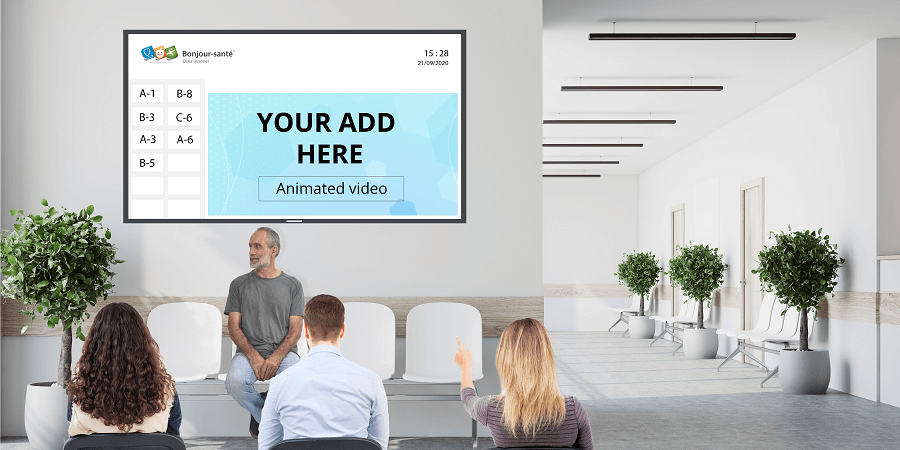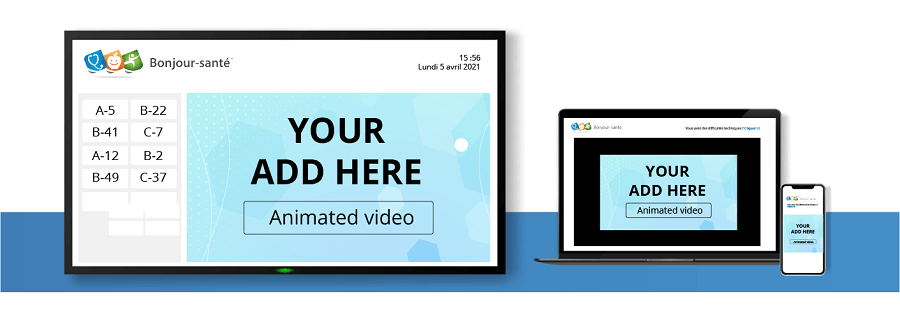A healthcare waiting room isn’t normally anybody’s idea of a good time – they’re usually kind of boring. But with Bonjour-santé, waiting rooms across Quebec are delivering the engaging content and useful information that patients crave when waiting for their turn to meet with the doctor. And that’s thanks to the power of DOOH.
Doing waiting rooms better
Bonjour-santé’s mission is to use innovative ideas and technology to drive a more efficient and pleasant experience in healthcare. Core to that mission is a booking system that allows patients to book consultations with family physicians, as well as for “walk-in” patients to book appointments with doctors and specialists. The goal is to greatly reduce the amount of time actually waiting in a waiting room, and eliminate the early-morning rush that sees would-be patients arrive in a flood and all wait around until it’s their turn to be seen.
It’s once patients are waiting for their appointment that the next phase of the Bonjour-santé experience, driven by the Bonjour-santé Media division, begins. In clinics and doctors’ offices, screens display updating information about which patient number is up and notices regarding local policies or, during the pandemic, COVID guidance. These are placed alongside useful information regarding health and nutrition, as well as advertising content delivered by relevant brands looking to connect with a health-conscious audience.
It’s the kind of friendly and useful information that makes a wait time feel a little nicer, and it’s proving popular with doctors and specialists across Bonjour-santé’s home province of Quebec, and beyond.

And improving virtual waits, too
Among the many changes COVID introduced in the healthcare space was a reduction in in-person clinic visits, which of course had an effect on demand for in-clinic advertising. Unwilling to wait out the pandemic, Bonjour-santé instead rolled out a tool for booking virtual appointments with doctors – something that patients indicated they wanted. And they took their existing approach to content and advertising and brought it to the online space.
Wanting to both manage online content from the same tool that they used for their in-clinic displays, as well as to provide a consistent experience to patients no matter where they were, Bonjour-santé Media elected to work with Broadsign to create a custom solution.
As with their on-location displays, content delivered to Bonjour-santé’s digital waiting rooms is scheduled with the Broadsign Control CMS. It is delivered, however, by Broadsign Air, Broadsign’s ad server for non-Broadsign players. Instead of serving the content to a digital signage player attached to a display, Air instead produces content playlists that sync with a system developed in-house by Bonjour-santé. This allows Bonjour-santé’s web solutions to pull up the same content that would appear on real displays in the clinic, placing it right there in the browser for the patients to see while they wait for their virtual appointment to start.
It’s an interesting implementation of a tool designed for digital out-of-home, one that offers a good example of how to solve new challenges for delivering content and advertising to users in virtual spaces just as you would in traditional OOH environments.

Empowering clinics to communicate with patients
Medical establishments are nothing if not busy, and with a constant flow of newcomers needing to ask similar questions throughout the day, there’s a real opportunity to improve efficiency and patient-friendliness with intelligent messaging tools. Offering its customers access to Broadsign Publish, a template-based content and messaging system, has allowed Bonjour-santé to do just that.
At a basic level, the system is useful for delivering messages relevant to the people there in the clinic at a given time. There might be a message regarding the on-site pharmacy’s hours or holiday hours, for example, or an occasional reminder to go and pay up the parking meter. And because all of the content is template-based, it’s easy for local users without specialized training to update content while preserving the desired look and branding.

But in circumstances that call for special attention, such as the COVID pandemic, the tool can take on even greater usefulness. Local or government policies can easily be updated and shared as required, and special health tips can be shared to educate patients who are waiting. Even simpler messages, such as to outline the entrance and exit areas for the room to minimize crowding, can be great candidates for this sort of system.
For medical coordinators tasked with keeping patients informed and engaged and also keeping the location efficient, these kinds of capabilities work wonders to reduce the workload and maintain high-quality service for patients.
Bonjour-santé Media and Broadsign
To build a distributed network of real-world and virtual waiting room displays, Bonjour-santé required a software solution that would allow centralized management of a large number of screens. Given the sensitive nature of the environments in which its displays are found, Bonjour-santé also needed to ensure the solution would have top-notch security to safeguard the information. And, of course, the solution needed to be able to accommodate all kinds of content, including video, advertising, and locally generated messaging.
Bonjour-santé Media found exactly what it was looking for with Broadsign. Broadsign Control and Broadsign Air ad server streamline the content scheduling and delivery processes for all of its content needs, and Broadsign Publish empowers local teams to share important information specific to their locations. Perhaps best of all, the extensibility and flexibility of the solutions mean that innovative ideas like Bonjour-santé’s digital waiting rooms are well within reach whenever Bonjour-santé comes up with its next big idea.
Want to make your waiting room screens smarter with Broadsign?
Contact us to get started






